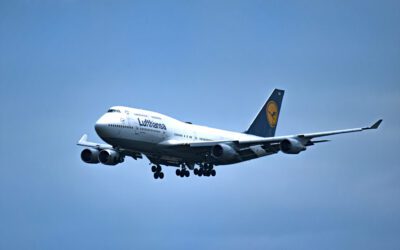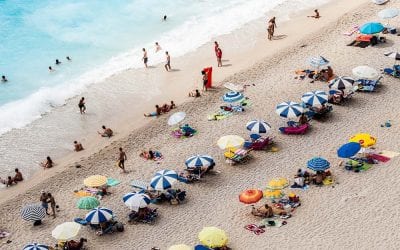Whether you’re on a short flight, or a long, transoceanic flight, how you dress can make a difference to your health, comfort, mood at landing, and whether or not you’re permitted to fly at all. It can even help you in case of a crash.
Knowing what to wear and not to wear while flying can be crucial for you.
Don’t wear tight fitting clothing
When sitting for a prolonged period, tight fitting clothes will feel more and more uncomfortable as your flight drags on. It’s hard to move around in airplane cabins, especially in economy, so if you’re partial to skinny jeans and tight fitting tops, pack them instead of wearing them on your flights.
Wear comfortable clothes that give you room to breathe, but don’t wear clothes that are too loose or elaborate. In an emergency evacuation of your plane, such clothing can get snagged on seats and obstacles, especially if the plane’s damaged.
Don’t wear sandals, flip-flops or high heels
In case of a crash, when exiting the plane, sandals and flip-flops give you no protection from debris, some of which can be very sharp. High heels may make a great airborne fashion statement, but they hinder passengers from safely evacuating a plane and can puncture an evacuation slide.
Wear clothing made with natural fibers
Clothing made with natural, breathable fibers are the most comfortable to wear, and handle temperature variations well. In the event of a fiery crash, synthetics or high-synthetic-content blends can literally melt on your skin, causing serious and potentially fatal wounds.
Older air travelers should consider compression socks for very long flights
Airplane cabins are typically pressurized to between 6,000-8,000 feet above sea level, and have their humidity set to 5-15 percent, lower than typically found in the Mojave Desert. Pressurization, low humidity and immobility during long flights in cramped seats leads to the potential of deep vein thrombosis (DVT) for passengers. It’s a potentially life-threatening condition.
If you’re an older air traveler, significantly overweight, or have other DVT risks, the American College of Chest Physicians recommends the use of properly fitted graduated compression socks. For all travelers on long flights, getting up periodically and exercising one’s legs is also recommended.
Avoid skimpy and potentially offensive clothing
Some travelers seem to need to dress in clothing some would call provocative or rude, while others wear clothes with pictures, cartoons or text some would consider insulting or disparaging.
If it’s important to you to get to your destination on time, and with as little hassle as possible, don’t wear skimpy or revealing clothing, or apparel with graphics or words anyone would consider offensive. They can result in you being kicked off your flight.
Malinda Knowles was removed from her JetBlue flight due to her baggy T-shirt and skimpy denim shorts. Lorrie Heasley was thrown off a Southwest flight for refusing to cover up her T-shirt sporting a political statement that the airline considered offensive. US Airways removed Deshon Marman from his flight because his pants sagged too low and revealed the top of his underwear.
Whether or not you agree with the airlines, if you want to fly, use common sense when you dress before leaving for the airport.
Dress in layers for your flight
You never know what temperature the flight crew will set for your plane’s cabin. I was on a Lufthansa flight not long ago during which I stayed in a short sleeve shirt the entire flight, but recently, on American Airlines, I quickly donned a warm-up jacket for the entire flight. Be prepared for a range of temperatures which sometimes change as flights proceed by wearing layered clothing.
Wear darker toned clothes or prints
Light-colored clothes show every spill, stain, smear and crease. Darker clothes can camouflage them. It’s likely that after landing you’ll be wearing the clothes you flew in for at least part of the upcoming day, so if you want to look good, light-colored clothes are a poor idea, even in summer.
I also suggest always bringing a spare set of clothes in your carry-on, in case of a bad spill. About ten years ago, soon after takeoff on a transcontinental flight to Los Angeles, the passenger next to me spilled his soda in my lap. Thankfully, I was able to change into my spare pants and shirt, or I would have been a wet mess for the next five hours.
Wear clothes with lots of pockets
In recent years, some airlines, including American and United, reduced their carry-on size limits. Despite the smaller limits, valuables, electronics, breakables, medications and other belongings still should be packed in your carry-on.
When I fly, I wear a pocketed vest, similar to the Scottevest which many wear while traveling. In addition to freeing space in my carry-on, it helps me at airport security. I put my change, wallet, cellphone, headset, passport etc. in the vest’s zippered pockets, before placing it in a tray. It keeps my belongings organized and unseen, making it easier to pass through security and prevent theft.
Air travel these days is full of obstacles, but using the suggestions in this list may help make your flights easier and more pleasant.
(Image: American Airlines A319 landing at Philadelphia International Airport, Copyright © 2015 NSL Photography. All Rights Reserved.)
After many years working in corporate America as a chemical engineer, executive and eventually CFO of a multinational manufacturer, Ned founded a tech consulting company and later restarted NSL Photography, his photography business. Before entering the corporate world, Ned worked as a Public Health Engineer for the Philadelphia Department of Public Health. As a well known corporate, travel and wildlife photographer, Ned travels the world writing about travel and photography, as well as running photography workshops, seminars and photowalks. Visit Ned’s Photography Blog and Galleries.



